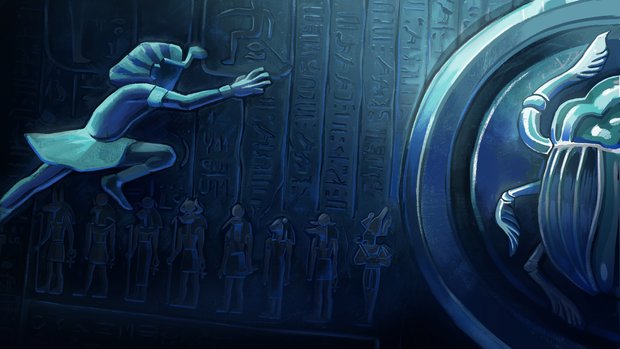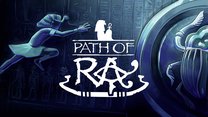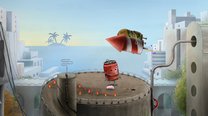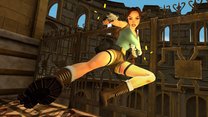Path of Ra review

- 0 Comments
Let the superficial story slide for some ancient Egyptian afterlife puzzling fun
Death in ancient Egypt was serious business. In this life, ritual mummification, elaborate religious ceremonies, and various objects and texts buried with the deceased helped ensure that they were prepared for their postmortem journey. Whether you were a commoner or the pharaoh, upon passing into the Duat, the land of the dead, things only got tougher, though a pharaoh did have the privilege of using a boat for transport. Successfully navigating through the Duat meant passing through various gates and doors that were often guarded by knife-wielding deities. And even if one managed to overcame all these, the dead’s very heart still had to be weighed against the lightness of a feather before one’s ultimate fate would be pronounced.
Oneiric Tales’ Path of Ra cleverly presents the challenges of this journey through the Egyptian afterlife as a tile-swapping puzzle game. Here, players must guide a murdered pharaoh across 66 levels, replete with obstacles like deadly enemies, barriers that must be opened, and floors that collapse when run across, which provide a decent challenge. The variety of Egyptian-style tunes are enjoyable, and while the plot is fairly basic, the animated cinematics are attractive and enhance the ancient cultural aesthetic. A lot of failure is inevitable along the way, but puzzle-oriented gamers and ancient Egypt enthusiasts will likely find Path of Ra a worthwhile, though brief, investment of their time.
Each level in Path of Ra consists of a grid of stone-like tiles framed by various backgrounds reminiscent of the bas-relief carvings found throughout Egypt. The grid varies in size and shape between each level, but generally the number of tiles increases as you progress. While some tiles contain only empty space, most of them feature a certain object, such as a scintillating jewel, flame-throwing sculpture, a gate, or an enemy, among a variety of other elements. One of the tiles will inevitably contain the pharaoh himself, and another the exit gate for that level. The tiles are initially in a scrambled state, with the goal being to swap the locations of the tiles with each other until a viable path can be found for the pharaoh to run to the exit.

By visual appearance alone, you might be reminded of the dreaded slider puzzle that has been the bane of many adventure gamers for what seems like forever, and to a certain extent that’s true on a larger environmental scale. And yet Path of Ra doesn’t play like a slider puzzle at all. To traverse each level, you must also interact with various objects to accomplish tasks within it, removing obstacles in the pharaoh’s way, such as opening gates, disabling traps, and avoiding or vanquishing opponents that threaten to kill him.
This is easier said than done, for the most part. While the early levels are generally simpler to unscramble, later stages have so many obstacles to overcome that trying to understand how everything will fit together is both head-scratchingly challenging and satisfying if you manage to suss out the solution without resorting to hints. Does the pharaoh need to crush this jewel to open this gate first, or should he eliminate this enemy before disabling the fire-emitting sconce on the wall? One must also be wary of leading him straight off the edge of the grid, setting up walls where necessary to guide him away from certain death.
Once you think you have the tiles placed in the right sequence and are ready to see if the pharaoh can make it to the exit, simply click the big “play” triangle in the lower left of the screen, and off the pharaoh goes to either move to the next level, get stuck with no way out, or die an ignominious death (at which point the level starts again, but with your modifications to the board intact). You do not need to instruct the pharaoh as to what to do next or where to go. Whichever direction he is facing at the start of the level, he will simply run until reaching an object or obstacle in a given tile, and then automatically perform the appropriate action, whether that is to kill (or be killed by) an enemy, crush a jewel, or turn around if he hits a wall.

These challenges will keep you quite busy throughout the 2-3 hours of playtime, and I suspect that puzzle lovers will have a very good time. However, there is a fair bit more trial and error than I was expecting. I blame much of this on my own difficulties being able to visualize and anticipate the results of putting tiles in various positions, as opposed to a particular flaw in the game mechanics. With enough patience, I expect most players (especially the stubborn persistent ones) will have just the right amount of trouble with the challenges presented here to feel amply rewarded upon finally reaching the solution.
For those with less patience, the try-everything-everywhere approach has its tile-based equivalent in Path of Ra, where you simply swap tiles around mindlessly until you make enough progress to blunder your way to the exit. But given that there are often an incredibly high number of swap possibilities, even that approach isn’t always feasible if you’re well and truly stuck. Fortunately, the lightbulb icon waiting patiently in the lower right of the screen may provide just enough light to illuminate your path. Clicking it shows which tiles are in the correct locations, and which are still scrambled. I appreciate this type of hint system, as it tends to provide you with just enough information to not completely spoil the solution.
The PC controls are dead simple (pun definitely intended), exclusively using the mouse. In addition to the aforementioned play and hint buttons, there is also a right-pointing arrow next to the play button that opens a small menu, where the settings, level reset, and exit buttons reside. The reset button does precisely what it sounds like: it reverts the level’s tiles back to the position they were in when the level was unlocked. Once completed, each stage can be accessed individually from the “Chapters” option on the main menu, where they’re all artfully depicted as a star in the sky. There is no in-game incentive to replay the levels, but a Steam achievement is available to those who cumulatively play 100 levels.
Presented in third person with a 2D perspective, Path of Ra’s animated graphic style is attractive, with familiar sand tones punctuated by colors such as reds, greens, and blues one expects of the ancient Egyptian setting. Each scene contains animated effects that lend an interesting sense of dynamism, such as out-of-focus grains of dust swirling around, flickering flames, and even the pharaoh bobbing up and down as if in anticipation of running the current gauntlet. The visual flair of tiles popping out of the board upon selection and settling back in once released also provides a sense of polish to what is otherwise a very basic function. Cutscenes, though few and far between, are also very well done, illustrated in much the same painterly cartoon style as the in-game action.
The soundtrack features a variety of high- and low-tempo tunes, and is at times toe-tappingly enjoyable with its lush Egyptian-style scores. Sound effects heard throughout bring the game to life, whether a sword crashing, a gate opening, or the chain-like rattling that accompanies a main menu selection. Overall, the palette of sounds in Path of Ra is well-placed thematically and enhances the overall atmosphere.
The story of the pharaoh’s life, including the events that led to his assassination, is gradually revealed through cutscenes interspersed rather sparingly between certain levels. It is a very basic revenge story, told entirely through action and pantomime rather than dialogue, and whose conclusion is rather predictable, save for one element that I wasn’t anticipating. The narrative – what there is of it, at least – feels more like a framing device than anything else. Ultimately you should play Path of Ra for the puzzles, rather than expecting the mystery of who killed the pharaoh to draw you in. That the story isn’t particularly integral to the overall gameplay isn’t a bad thing per se, and the entire game can be viewed as one long tale of the pharaoh’s journey into the afterlife, but it does strike me as having wasted a fair bit of potential.
Final Verdict
All in all, I enjoyed my time with Path of Ra as a fun little puzzler. While trial and error seems inevitable at times, given how complex the levels can become, it’s easy to get swept up in the move-planning, tile-swapping challenge on offer. Expect to fail many times, but when you need a nudge in the right direction, the hint system works very well to get you going again. The simple revenge story is somewhat disappointing, given that it doesn’t feel like an integral part of the game, and is somewhat predictable in its conclusion. The controls are very polished, however, and the graphics and cutscenes are enjoyable to watch, while the music and sound effects are likewise well-suited to the ancient Egyptian aesthetic. The playtime seems a bit on the short side, but inveterate puzzle fanatics may just find Path of Ra to be a journey worth embarking on.
Hot take
Path of Ra is a fun little ancient Egypt-themed tile-swapper that provides a decent challenge for puzzle fans looking for an atmospheric diversion, though a lackluster story that provides little more than a basic framework seems like a lost opportunity.
Pros
- Tile-swapping mechanics provide a decent challenge for puzzle lovers, both new and experienced
- Ancient Egyptian atmosphere is brought to life by attractive graphics, cutscenes, and music
- Hints are useful without giving too much away
Cons
- Predictable story is little more than a framing device for the puzzles
- Short playtime, even with some unavoidable trial and error
Kacey played Path of Ra on PC using a review code provided by the game's publisher.









0 Comments
Want to join the discussion? Leave a comment as guest, sign in or register.
Leave a comment